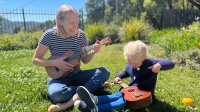Adding Music to Your Classroom With a Ukulele
The ukulele is a relatively simple instrument to learn, and teachers can use this skill in several ways to engage young students.
Your content has been saved!
Go to My Saved Content.Music plays an important role in early childhood and primary grade classrooms, with many teachers using songs as part of meeting times, during transitions, and as part of the curriculum.
This inclusion of music is supported by ample research, including the work of Howard Gardner, who developed and popularized the concept of multiple intelligences. Gardner’s work identifies eight distinct intelligences, including verbal-linguistic, logical-mathematical, spatial, bodily-kinesthetic, interpersonal, intrapersonal, naturalist, and musical.
In his theory of multiple intelligences, Gardner argues that every person possesses each of these intelligences, that they can be cultivated, and that they sometimes overlap. In the case of musical intelligence, Gardner identifies it as “a separate intellectual competence” but notes that “music does relate in a variety of ways to the range of human symbol systems and intellectual competences,” including logical-mathematical and verbal-linguistic intelligences.
Starting Out
When I joined the kindergarten teaching team at Marin Country Day School several years ago, I was lucky to be welcomed onto a team with a strong musical tradition and its own canon of songs, many written by my colleague Doug Zesiger and his wife, Annie Zesiger. With music a core part of our social and emotional learning curriculum, I needed to cultivate my own musical intelligence and bought my first ukulele.
While I participated in orchestra and band growing up, I had not played an instrument in many years, and I found the ukulele to be an accessible tool to bring more music into the classroom. Each year that I’ve taught since joining the team, I’ve found myself using the ukulele more and more throughout the school day (and with my own children at home).
There are several reasons why the ukulele is a great choice for early childhood and elementary educators:
Simplicity: While there is a rich history of complex, beautiful ukulele music, the ukulele remains an accessible instrument for beginners. It has four strings (a guitar has six), making chord formation easier for the novice player.
Size: There are several types of ukuleles, including soprano, the smallest, and tenor, which is medium-sized. In my experience, the tenor is the most comfortable to play, since the neck is a little longer than that of the soprano. The chord formations are the same on soprano and tenor ukuleles.
Cost: Ukuleles are relatively affordable. Beginner models start at around $50, and the price goes up from there. But an entry-level ukulele is great for most classrooms.
While the ukulele is an approachable instrument for beginners, you should expect to spend some time learning the basics—especially if you don’t have a background with a stringed instrument. I spent my first several years learning from colleagues, watching videos online, and practicing songs from The Daily Ukulele, and I eventually decided to invest in a few lessons. After just a couple of sessions, I was much more confident with my strumming and transitions between chords.
However, lessons are not necessary to get started. With many popular children’s songs using just one or two chords, beginners can certainly jump right in.
Using the ukulele can enliven the music you are already creating in your classroom or can provide inspiration for new opportunities to sing and play.
5 Ways to Incorporate the Ukulele
1. Morning meeting and closing circle. Many classrooms use songs as a way to open and close the school day. If you don’t yet have a welcome or good morning song that you love, “Hello Everybody” is a wonderful song that the kids’ music company Music Together uses to open their classes. You can watch a tutorial on this song—there’s even a way to play it using just one chord.
2. Transitions. Using songs while lining up, coming to the rug, or cleaning up to transition to a new activity can help manage the energy in the room. I find that using songs this way minimizes the number of times I find myself redirecting children or ringing the chime to get their attention. You might choose to use specific songs for transitions, such as a designated cleanup song, or you can use songs that reinforce content you are learning as a way to get some extra practice while children line up.
3. Science. There are so many wonderful children’s songs that introduce and reinforce scientific concepts, especially in natural science. Classic children’s musicians like Sarah Pirtle, Raffi, and Ella Jenkins have songs about plants, animals, weather, and more. Consider introducing a science-themed song as one component of a new unit.
4. Phonics and word study. Many classic early childhood songs provide great opportunities to strengthen phonemic awareness and play with rhymes, alliteration, and manipulating words. In fact, many established phonics curricula incorporate songs and poems into their lessons. Setting poems to music or using the ukulele to accompany students as they sing old favorites can bring special energy to word study time.
Songs like “Willoughby Wallaby Woo,” by poet Dennis Lee, and “Apples and Bananas,” by Raffi, give children a chance to play with language. If your phonics curriculum uses poems, and you’d like to set them to music, a friend or music teacher might be able to help you create a simple chord progression.
5. Social and emotional learning. As with songs that support wordplay, many classic early childhood songs focus on self-regulation, peaceful interaction with others, and emotional literacy. Songs like Sarah Pirtle’s “My Roots Go Down” can be used to teach social and emotional skills through a nature-based lens.
While picking up a new instrument may feel daunting, bringing the ukulele into your classroom provides many opportunities for joyful exploration and learning.
